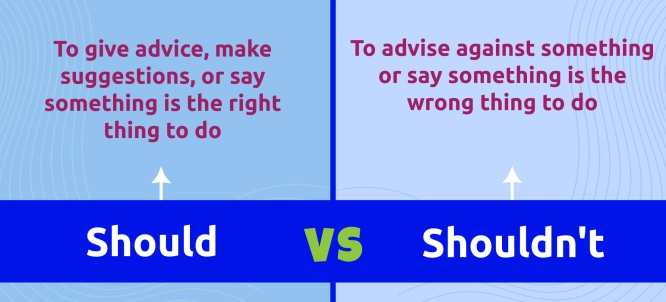by PushtoLearn
Should and Shouldn't
Table of Contents
Should and Shouldn't – Exercises
These exercises focus on Should and Shouldn't
What Are Should and Shouldn't?
|
Modal Verb |
Meaning/Use |
|
Should |
To give advice, make suggestions, or say something is the right thing to do. |
|
Shouldn't |
To advise against something or say something is the wrong thing to do. |
Example:
-
Should: "You should exercise regularly to stay healthy."
-
Shouldn't: "You shouldn’t eat too much junk food."

Forming Sentences with Should and Shouldn't
Affirmative Form (Should)
Structure:
Subject + should + base verb
|
Person |
Example |
|
I |
I should drink more water. |
|
You |
You should study for your test tomorrow. |
|
He/She/It |
She should visit a doctor. |
|
We |
We should help our neighbors. |
|
They |
They should arrive on time. |
Negative Form (Shouldn't)
Structure:
Subject + shouldn’t + base verb
|
Person |
Example |
|
I |
I shouldn’t skip breakfast. |
|
You |
You shouldn’t stay up too late. |
|
He/She/It |
He shouldn’t drive without a license. |
|
We |
We shouldn’t waste water. |
|
They |
They shouldn’t fight over small issues. |
Question Form
Structure:
Should + subject + base verb?
|
Question |
Example Answer |
|
Should I call her? |
Yes, you should. |
|
Should we bring snacks? |
No, we shouldn’t. |
|
Should he apologize? |
Yes, he should. |
Common Uses of Should and Shouldn't
-
Giving Advice
-
"You should drink more water to stay hydrated."
-
"You shouldn’t lie to your friends."
-
Expressing Obligation or Responsibility
-
"We should clean the house before guests arrive."
-
"He shouldn’t forget to finish his homework."
-
Making Recommendations
-
"They should try the new restaurant in town."
-
"You shouldn’t watch too much TV."
-
Expressing Opinions
-
"I think you should learn another language."
-
"In my opinion, she shouldn’t spend all her money at once."
Common Errors
|
Error |
Correction |
Why? |
|
Using "to" after should: "You should to eat." |
"You should eat." |
Modal verbs are followed by the base verb. |
|
Using "not" instead of shouldn’t: "You not eat junk food." |
"You shouldn’t eat junk food." |
"Should not" must be contracted as "shouldn’t" or used together. |
|
Adding -ing: "He should going now." |
"He should go now." |
Modal verbs never use -ing forms. |
|
Using a past tense verb: "We should went early." |
"We should go early." |
Modal verbs only use the base form of the verb. |
FAQ
What is the difference between “should” and “must”?
-
Should: Suggests advice or recommendation.
Example: "You should eat more vegetables." -
Must: Indicates a stronger obligation or necessity.
Example: "You must wear a seatbelt while driving."
Can “should” be used in the past tense?
No, but we use should have + past participle to talk about past advice.
Example: "You should have studied more for the exam."
What is the difference between “shouldn’t” and “mustn’t”?
-
Shouldn’t: Advises against something but is less strict.
Example: "You shouldn’t eat too much sugar." -
Mustn’t: Strongly forbids something.
Example: "You mustn’t smoke here. It’s illegal."
Can we use “should” for making predictions?
Yes, in some cases:
Example: "The bus should arrive in five minutes."
What is the contraction of “should not”?
The contraction is shouldn’t.
Example: "You shouldn’t be late for school."

